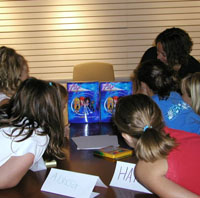Back in the day when toy testing meant playing with stand-alone toys instead of entire transmedia properties, I learned the importance of seeing a product in the hands of a user before critiquing it. As an editor, parent, and seasoned player, I thought I knew what looked good, seemed fun, and had good value, but I was often jarred back to reality when a three-year old couldn’t manipulate a toy meant for toddlers, or a six-year old was bored with a game I loved. I was recently reminded how important testing is while observing a bunch of 10-year olds in focus groups. They were looking at a website under construction that the creative adult “experts” thought was fabulous. There were just a few areas the developers wanted to test…presumably minor tweaks.
And then the consumers spoke.
They loved this. They hated that. They didn’t understand why the developers did something. Why they didn’t do something else. Where was the antagonist? Who made the rules? Could you invite friends? On and on and on.
Today’s multi-platform, multi-player, and multi-faceted products are as complicated as kids themselves. Whether you’re developing a toy, a game, a storyline, or an entire brand, if you don’t heed the reactions of those who will actually use it, you risk missing the bus.
My day of back-to-back focus groups drove home these key points:
Play it, don’t say it. Kids know what they like, even if they can’t articulate it. Body language, attention span, laughter, and engagement speak volumes. Listen carefully. Be willing to change.
Think globally. Kids are the center of their own world. Does yours take them to a world such as Panem, where life is scary? To Poptropica, where life is lovely? Or to Oz, where life is not really what it seems? When you have an engaging story or brand, the “where” doesn’t matter as much as the “how.”
One is a lonely number. Kids like other kids. They’re social, even when they’re too young for social media. Be age appropriate. But be edgy. Little kids like what big kids have. Encourage collaboration, sharing, and conversation. Everyone wants to have friends.
Take your time. Give yourself time to test…and time to make changes. No sense finding out something’s amiss when it’s too late to do anything about it. Build testing into every development plan.
It’s all about ME. Kids have a lot of choices. What can you offer them that they can’t get anywhere else? Don’t know? That’s the first question you should ask!
I’d love to hear your comments at wendy@sandboxsummit.org





















